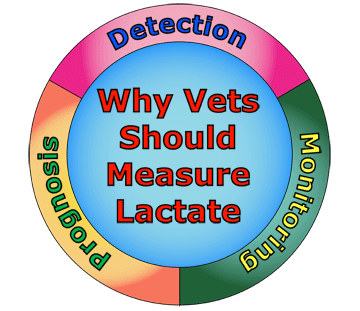|
|
| |
We do not have a background in veterinary medicine but
have asked some teachers at veterinary hospitals why and when lactate
should be measured in veterinary medicine. They replied that lactate
testing is often used for detection, prognosis and monitoring which
is the basis of the visual above. The following articles in the
literature were recommended to us.
A very good summary references for the use of lactate testing
for veterinarians is an article by Dez Hughes in Kirk's Current
Veterinary Therapy XIII Small Animal Practice (1999 pages 112-116)
which is edited by John Bonagura and published by W. B. Saunders.
In this article is a chart which lists the major causes of hyperlactatemia
that are relevant to veterinary medicine. A short summary of these
causes is:
- Issues of absolute or relative tissue hypoxia such as
shock, local hypoperfusion, severe hypoxemia, severe anemia, carbon
monoxide toxicity and excessive muscular activity.
- Issues where there is no clinical evidence of tissue
hypoxia. For example,
- in association with underlying diseases such as
diabetes mellitus, severe liver disease, malignancy, sepsis,
and others.
- due to drugs or toxins such as acetaminophen, cyanide,
epinephrine and others.
- due to inborn metabolic defects such as mitochondrial
myopathy.
See the article for a more complete discussion.
Another very detailed article appeared in the
April 2006 issue of Compendium. The article titled, "Lactate
Measurement as an Indicator of Perfusion" is by Michael H.
Karagiannis, Marie E. Kerl, F. A. Mann and Alisa N. Reniker. It
is available online if you have
a subscription at
http://www.vetlearn.com/ArticleDetails/tabid/106/ArticleID/301/Default.aspx
An abstract of the article is
With the advent of accurate, affordable, point-of-care
lactate monitors, use of plasma or blood lactate measurements
can provide valuable diagnostic information in treating critically
ill patients. Tissue hypoxia causes anaerobic metabolism, which
increases lactate production. Decreased perfusion is the most
common cause of hyperlactatemia in critically ill patients; however,
there are other causes of hyperlactatemia besides tissue hypoxia
(i.e., mitochondrial dysfunction, hypermetabolic states), and
collection techniques and sample handling can also affect results.
Serial blood lactate measurements can guide treatment by allowing
clinicians to assess improvements in tissue oxygenation and provide
prognostic information to clients.
|
| |
Some other references in the literature on how lactate
testing is used for veterinary uses are:
- Plasma Lactate Concentration as a Predictor of Gastric
Necrosis and Survival Among Dogs with Gastric Dilatation-Volvulus:
102 Cases (1995-1998) - J Am Vet Med Assoc 215[1]:49-52 Jul 1'99
Retrospective Study 28 Refs) Author(s): Erika de Papp, DVM; Kenneth
J. Drobatz, DVM, DACVIM, DACVECC; Dez Hughes, BVSC, DACVECC; Sections
of Medicine and Critical Care, Dept. of Clinical Studies, School
of Veterinary Medicine, University of Pennsylvania, Philadelphia,
PA 19104
- Lactate Kinetics in Veterinary Critical Care: A Review
- J Vet Emerg Crit Care 6[2]:81-95 Jul-Dec'96 Review Article 129
Refs) Author(s): Michael S. Lagutchik, DVM; Gregory K. Ogilvie,
DVM; Wayne E. Wingfield, MS, DVM*; Timothy B. Hackett, DVM, MS;
College of Veterinary Medicine and Biomedical Sciences, Colorado
State University, Fort Collins, CO 80523
- Increased Lactate Concentrations in Ill and Injured
Dogs - J Vet Emerg Crit Care 8[2]:117-127 May/Aug'98
Clinical Study 99 Refs Auhor(s) Michael S. Lagutchik, DVM; Gregory
K. Ogilvie, DVM; Timothy B. Hackett, DVM, MS; Wayne E. Wingfield,
MS, DVM Veterinary Teaching Hospital 300 W. Drake, Fort Collins,
CO 80523
|
| |
|

